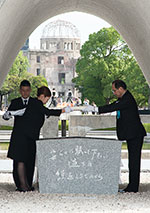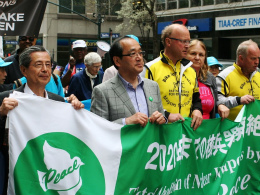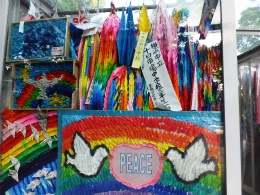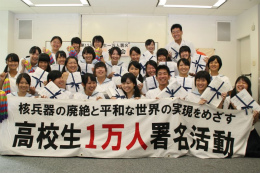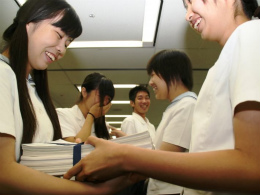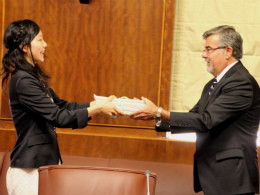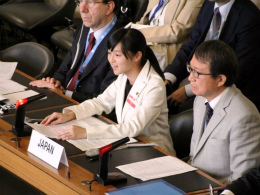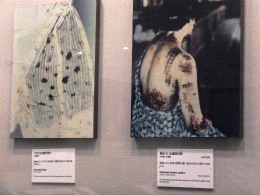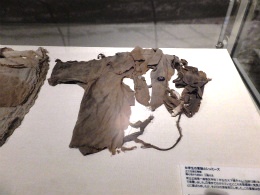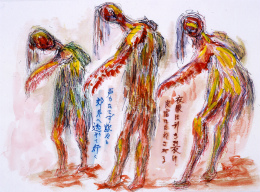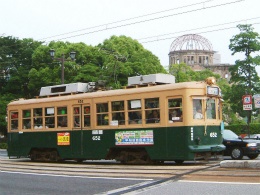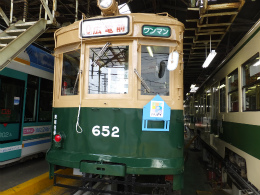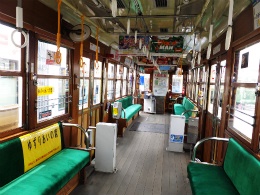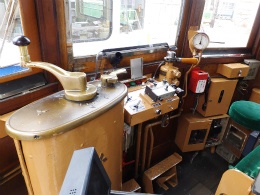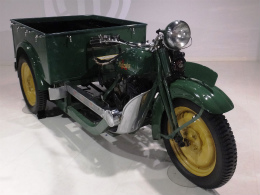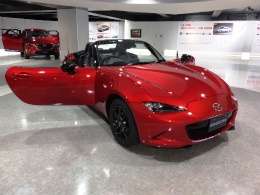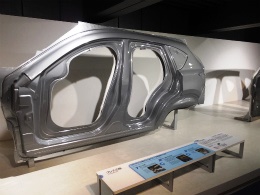実施日 : 2015年07月09日(木) - 10日(金)
Notice: Hiroshima Press Tour “70 Years After the War”
投稿日 : 2015年06月19日
- Voices from Hiroshima, 70 Years After the Bomb -
- Passing on Memories: Issues and New Efforts -
- Unique Local Companies, sharing the postwar path with Hiroshima -
–Voices from Hiroshima, 70 Years After the Bomb–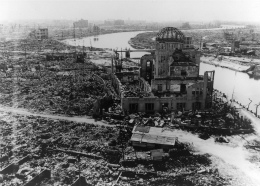
This year will mark 70 years since the atomic bomb was dropped on Hiroshima on August 6, 1945. A single bomb turned Hiroshima into a scorched barren, ending the lives of tens of thousands of people young and old in a singled day, and killing 140,000 people within the year. A unique characteristic of the atomic bombing was that in addition to the mass destruction and slaughter carried out instantaneously, people were also damaged over the long term by radiation.
As the first city in history to be attacked with a nuclear weapon, in order for this tragedy to never happen again after the war Hiroshima has pleaded with the world to abolish nuclear weapons and bring about peace. This year, the 70th anniversary of the bombing, the mayor of Hiroshima plans to make into a year to reconfirm the role of Hiroshima and share a dream of peace with the whole world.
– Passing on Memories: Issues and New Efforts–
With the average age of hibakusha (atomic bomb survivors) over 79 years old, the number of people who can directly speak about that tragedy is decreasing every year. (The total number of hibakusha, holders of the Atomic Bomb Survivor’s Certificate, from Hiroshima and Nagasaki was 192,719 as of 2014.) To deal with this issue, a project has begun to pass on those memories to younger generations who did not experience the bombing, and have them pass these memories on. Hiroshima city has gathered members of younger generations to train to become “successors” to the experiences of the hibakusha. The High School Peace Ambassador project is also very active in Hiroshima and around Japan, with high school students collecting signatures and bringing them to the UN to ask for the abolition of nuclear weapons
- Unique Local Companies, sharing the postwar path with Hiroshima -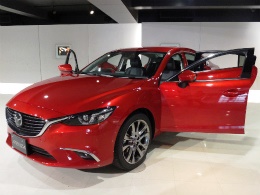
After the war, Hiroshima managed an amazing recovery from the burnt wasteland it had been turned to. There are many unique local companies who have walked this path together with Hiroshima. Mazda, an automobile manufacturer based in Hiroshima, restarted manufacturing three-wheeled trucks only four months after the bombing. The company supported Hiroshima’s reconstruction and became a foundation of the local economy and industry with diverse automobile production. There is also a company that developed a sauce specifically for okonomiyaki, Hiroshima’s soul food during the shortages after the war.
-------------------------------------------------------------------------------------------------------------------
●This tour will visit Hiroshima, and interview the mayor and hibakusha to hear the voices of the people 70 years after the atomic bomb.
●As the hibakusha grow older and passing on their experiences becomes an issue, a new effort has begun to train younger generations as “successors” to carry on the hibakusha’s memories. The tour will speak to these successors and local high school students. The tour will also cover streetcars that experienced the bombing and still run, the Hiroshima Peace Memorial Museum, and the Atomic Bomb Dome.
●The tour will also cover unique local companies who have experienced postwar reconstruction along with Hiroshima: Mazda, an automobile manufacturer that is popular overseas and posted record profits in the last fiscal year, and Otafuku Sauce, an okonomiyaki sauce maker.
-------------------------------------------------------------------------------------------------------------------
*This press tour is jointly planned and sponsored by Hiroshima City and the FPCJ.
[Tour Details]
―――Voices from Hiroshima, 70 Years After the Bomb―――
1. Interview with Hiroshima Mayor Kazumi Matsui
Message from Hiroshima 70 years after the atomic bombing
http://www.city.hiroshima.lg.jp/www/genre/1001000002088/index.html
http://www.city.hiroshima.lg.jp/www/contents/1317948556078/index.html
(Hiroshima Mayor’s Peace Declaration (2014) Available in 10 languages: English, Chinese, Korean, etc.)
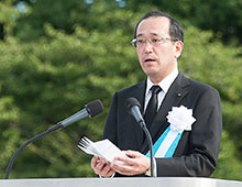 70 years ago, Hiroshima was devastated by an atomic bomb. As the first city in human history to be attacked with a nuclear weapon, Hiroshima has continued to work towards nuclear disarmament and world peace.
70 years ago, Hiroshima was devastated by an atomic bomb. As the first city in human history to be attacked with a nuclear weapon, Hiroshima has continued to work towards nuclear disarmament and world peace.
On the 70th anniversary of the bombing, the mayor of Hiroshima wants to reconfirm the role of Hiroshima as an A-bombed city, and share the desire for peace with the whole world. Mayor Matsui is the first mayor of Hiroshima who was born after the war, and his mother is hibakusha. In the Peace Declaration released on August 6 last year, he quoted the following passage from the journal of a hibakusha, touching on how their pain continues to this day:
“Water, please.” Voices from the brink of death are still lodged in the memory of a boy who was 15 and a junior high student. The pleas were from younger students who had been demolishing buildings. Seeing their badly burned, grotesquely swollen faces, eyebrows and eyelashes singed off, school uniforms in ragged tatters due to the heat ray, he tried to respond but was stopped. “Give water when they’re injured that bad and they’ll die, boy,‟ so I closed my ears and refused them water. If I had known they were going to die anyway, I would have given them all the water they wanted.” Profound regret persists.
The average age of hibakusha is over 79 years old, and Hiroshima is urging the Japanese government to follow foreign policy seeking the creation of new legal frameworks such as a nuclear weapons convention in order to bring about nuclear disarmament as soon as possible. The declaration also calls on the world’s policymakers, especially those of nuclear-armed nations, to visit Hiroshima and see what happened when it was bombed, to share the experiences of hibakusha and their wish for peace, and to work towards nuclear disarmament.
◆The mayor will speak about sending a message from Hiroshima, an atomic-bombed city, to the world.
2. Interview with a Survivor (hibakusha): Hiroshima A-bomb Survivors’ Association, President Sunao Tsuboi (90)
After experiencing the bomb at the age of 20, 70 years of fighting against the pain caused by nuclear weapons
http://www.ne.jp/asahi/hidankyo/nihon/english/index.html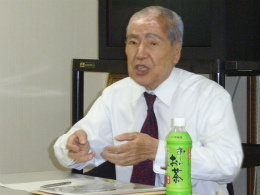
When the atomic bomb was dropped on Hiroshima on August 6, 1945, Mr. Tsuboi, who was 20 years old at the time, was on his way to school at Hiroshima Technical School (the present-day Hiroshima University Faculty of Engineering), and was approximately one kilometer from ground zero. He received severe burns on his face and arms, and although he fell unconscious his mother desperately searched for and saved him. He was in a coma for 40 days, and even after waking up it was a year until he could stand. Even after the war, he faced prejudice as hibakusha when getting married, and has been tortured by many illnesses, including multiple cancers, due to radiation from the bomb.
After working for many years as a junior high school teacher, Mr. Tsuboi has been actively involved in efforts to communicate the experiences of hibakusha to both people in Japan and overseas. He has gone overseas a total of 21 times, to over 10 countries, in order to protest nuclear testing and encourage peace. Regarding the lack of agreement on the final document of the Treaty on the Non-Proliferation of Nuclear Weapons at the Review Conference this year, his frustration was clear in his comments that “They’re moving backwards. It is extremely regrettable.” However, he describes his current stance, 70 years after the bomb, by saying “As long as I still breathe, I will keep protesting war and nuclear weapons.”
◆Mr. Tsuboi will speak on his experience during the bombing, his feelings now 70 years after the bomb, and global topics, such as the NPT, dealing with nuclear weapons.
―――Passing on Memories: Issues and New Efforts―――
3. Project to Train Younger Generations as Successors to the Memories of Hibakusha, Ms. Minako Omatsu (43)
Passing the feelings of hibakusha onto the future
http://www.pcf.city.hiroshima.jp/hpcf/oshirase/H27_successor/index.html
http://www.city.hiroshima.lg.jp/www/contents/1335957115477/index.html
http://www.city.hiroshima.lg.jp/www/contents/1110598417580/index.html
- Members of the younger generation listen to stories from hibakusha, and spend three years to become a “successor”
 70 years after the bomb, the average age of hibakusha is now over 79 years old, and the number of people who can explain their experiences personally is decreasing. To deal with this issue, a project is underway to pass on the memories of the bombing to younger generations who did not experience it, and have them take over the role of communicating those memories. A project was started in the 2012 fiscal year to gather members of the younger generation, have them listen to the experiences of hibakusha and, over the course of three years, become successors to pass on those stories in the future. In April 2015, the first group of 50 finished their training, and take turns daily telling visitors to the Hiroshima Peace Memorial Park about the stories of hibakusha. Some of them are also telling these stories in foreign languages. The first group of successors consists of men and women, with ages ranging from 30s to 70s. There are not only second and third generation hibakusha whose parents or grandparents are hibakusha, but also people from other areas and those with no particular relation to any hibakusha. Each member chooses which hibakusha’s experiences to carry on, and focuses on that one person, listening to and recording their childhood memories, what it was like when the bomb dropped, what they have felt over the course of their lives, and their wishes for peace.
70 years after the bomb, the average age of hibakusha is now over 79 years old, and the number of people who can explain their experiences personally is decreasing. To deal with this issue, a project is underway to pass on the memories of the bombing to younger generations who did not experience it, and have them take over the role of communicating those memories. A project was started in the 2012 fiscal year to gather members of the younger generation, have them listen to the experiences of hibakusha and, over the course of three years, become successors to pass on those stories in the future. In April 2015, the first group of 50 finished their training, and take turns daily telling visitors to the Hiroshima Peace Memorial Park about the stories of hibakusha. Some of them are also telling these stories in foreign languages. The first group of successors consists of men and women, with ages ranging from 30s to 70s. There are not only second and third generation hibakusha whose parents or grandparents are hibakusha, but also people from other areas and those with no particular relation to any hibakusha. Each member chooses which hibakusha’s experiences to carry on, and focuses on that one person, listening to and recording their childhood memories, what it was like when the bomb dropped, what they have felt over the course of their lives, and their wishes for peace.
- The Feelings of the Younger Generation Aiming to Become Successors
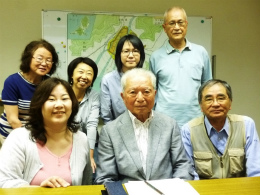 Currently, there are 141 people training as part of the project. A member of the second group of trainees, in her third year, Ms. Minako Omatsu (43) is from Kagawa. None of her relatives are hibakusha, and she moved to Hiroshima when she entered university. When she first visited Hiroshima in her teens and saw the Atomic Bomb Dome, she says “I was shocked at how people the same age as me had died in an instant, and worried about that memory being forgotten.” It was this thought that inspired her to join the project. When she heard they were looking for successors, she was hesitant about handling such a heavy theme even though she didn’t have any direct connection to the bombing, but decided to join in the end. “There won’t be any hibakusha left one day. The more people there are to tell their stories, the better. I may not be from Hiroshima, but I was still born in Japan, the only country to be atomic bombed, and considering it as a mistake by humanity as a whole, nationality is irrelevant.”
Currently, there are 141 people training as part of the project. A member of the second group of trainees, in her third year, Ms. Minako Omatsu (43) is from Kagawa. None of her relatives are hibakusha, and she moved to Hiroshima when she entered university. When she first visited Hiroshima in her teens and saw the Atomic Bomb Dome, she says “I was shocked at how people the same age as me had died in an instant, and worried about that memory being forgotten.” It was this thought that inspired her to join the project. When she heard they were looking for successors, she was hesitant about handling such a heavy theme even though she didn’t have any direct connection to the bombing, but decided to join in the end. “There won’t be any hibakusha left one day. The more people there are to tell their stories, the better. I may not be from Hiroshima, but I was still born in Japan, the only country to be atomic bombed, and considering it as a mistake by humanity as a whole, nationality is irrelevant.”
 Still, she was conflicted over whether she could communicate anything as well as someone who had experienced the bombing themselves, and when it is possible to record them on video, what could someone like her do? The hibakusha she is succeeding is Mr. Masahiro Kunishige (84), who is intent to pass on all the painful memories he wants to forget, saying “Can I really die and leave behind a world with nuclear weapons?” As Ms. Omatsu spoke with him and got to know him more, her desire to tell as many people about him grew. She also began to think that maybe there were elements she could communicate because she was not a hibakusha herself, and instead observed the pain of the hibakusha. “By having known hibakusha directly, I can add my own feelings to those of the hibakusha, and pass them on to the next generation.”
Still, she was conflicted over whether she could communicate anything as well as someone who had experienced the bombing themselves, and when it is possible to record them on video, what could someone like her do? The hibakusha she is succeeding is Mr. Masahiro Kunishige (84), who is intent to pass on all the painful memories he wants to forget, saying “Can I really die and leave behind a world with nuclear weapons?” As Ms. Omatsu spoke with him and got to know him more, her desire to tell as many people about him grew. She also began to think that maybe there were elements she could communicate because she was not a hibakusha herself, and instead observed the pain of the hibakusha. “By having known hibakusha directly, I can add my own feelings to those of the hibakusha, and pass them on to the next generation.”
◆Ms. Minako Omatsu, in her third year of training as a successor, will speak about why she decided to become a successor, and what activities she will be involved in as one.
4. High School Peace Ambassadors
Teens urging the UN to abolish nuclear weapons. Petitions with over 1.17 million signatures
18th High School Peace Ambassador, Ms. Tsugumi Inoue, Prefectural Hiroshima High School, First-Year Student
17th High School Peace Ambassador, Ms. Misaki Katayama, Prefectural Hiroshima High School, Second-Year Student
15th High School Peace Ambassador, Ms. Mami Kuwahara, Hiroshima Jogakuin High School, Graduate
http://peacefulworld10000.com/
The High School Peace Ambassador Project has high school students from around the country apply to go to the UN and act as a messenger calling for bring about a peaceful world and the abolishment of nuclear weapons. In 1998, a citizen’s group in Nagasaki was increasingly concerned over repeated nuclear experimentation, and started this project to have people around the world hear from areas that knew of the horror of nuclear weapons from experience. From 2001, based on a suggestion from high school students, they have also been gathering signatures asking for the abolishment of nuclear weapons and bringing about world peace. High school students spend a year gathering signatures, and then bring them to the United Nations Office for Disarmament Affairs at the UN Office in Geneva, Switzerland where they give a speech asking for the abolishment of nuclear weapons. 131,700 signatures were presented in 2014 alone. The total since 2001 is 1,173,400 signatures, and these are all being kept permanently at the UN. High school students in the Philippines and South Korea also collect signatures, and the movement is becoming international.
Since there are also a lot of hibakusha in Korea, who were present in Hiroshima and Nagasaki when they were bombed, high school students also travel to Korea to meet with Korean hibakusha.
This year, the 18th year of the project, 22 students from 16 prefectures, the most so far, were selected as peace ambassadors. Two students from Hiroshima were also selected.
◆Interview with Ms. Tsugumi Inoue (first-year high school student), who this summer will go to the UN Office in Geneva as a high school peace ambassador representing Hiroshima, and two former peace ambassadors.
5. Atomic Bomb Dome and Hiroshima Peace Memorial Museum
A place where people from around the world visit and learn the horrors of the atomic bomb
- Hiroshima Peace Memorial Museum -
http://www.pcf.city.hiroshima.jp/index_e2.html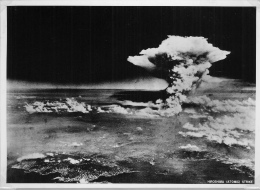
The Hiroshima Peace Memorial Museum has exhibits and archives of the former possessions of hibakusha, photos and documents showing the horrors of the bombing, the state of Hiroshima before and after the bombing, and the Atomic Age following the dropping of the bomb as more and more countries around the world acquired nuclear weapons. The museum has a collection of approximately 21,000 items such as school uniforms that students were wearing when they died, charred lunch boxes, and glass bottles melted from the heat. With many lives stolen in an instant, leaving behind only these mementos, in many cases there was no body or even bones left to send to their relatives. Many of the items displayed were found by people looking through the rubble for their loved ones. There are approximately 1.3 million visitors to the museum annually, and many of them are from other countries. Many famous people such as Pope John Paul II and Mother Teresa have visited the museum and left messages wishing for peace. Many heads of states have also visited the museum.
- Atomic Bomb Dome -
http://www.city.hiroshima.lg.jp/www/dome/index.html
The original building was designed by a Czech architect and built in 1915 as a place to sell goods from Hiroshima Prefecture. It was one of Hiroshima’s modern landmarks at the time. In 1945, the atomic bomb exploded 160 meters southeast of the building, 600 meters in the air. The pressure of the explosion was 35 tons per square meter, with a wind speed of 440 meters a second, severely damaging the building in the blast and heat, and instantly killing all those inside. For some time after the war, there was a risk of the Dome being forgotten, but donations were collected from Japan and abroad for a large-scale preservation project, and in 1996 it was registered on the UNESCO list of World Heritage Sites. It now acts as a symbol for Hiroshima’s efforts to abolish nuclear weapons.
◆After visiting the Hiroshima Peace Memorial Park and photographing the Atomic Bomb Dome, the tour will go to the Hiroshima Peace Memorial Museum.
6. Hiroshima Peace Culture Foundation, Chairperson Yasuyoshi Komizo
The courage to escape from nuclear deterrence, based on distrust and threats
http://www.pcf.city.hiroshima.jp/hpcf/english/index.html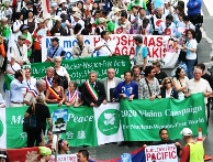
http://www.mayorsforpeace.org/english/index.html
The Hiroshima Peace Culture Foundation (HPCF) is entrusted by the City of Hiroshima with managing the Hiroshima Peace Memorial Museum, and also operates the secretariat for Mayors for Peace. Mayors for Peace was established in 1982 based on a proposal by the City of Hiroshima, and currently has 6,706 member cities from 160 countries. Their 2020 Vision Campaign has the goal of abolishing nuclear weapons by 2020. Municipalities that join the campaign agree to work towards abolishing nuclear weapons by 2020, and to support negotiations to that end. They are also working towards agreement on a nuclear weapons convention banning the research, development, storage and use of nuclear weapons.
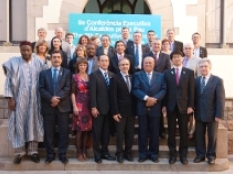 Even now, more than 20 years after the end of the Cold War, there are 15,850 nuclear weapons existing in the world, with the risk of nuclear proliferation and nuclear terrorism. Mr. Komizo, the chairperson of the HPCF, believes that it is important for members of civil society to work on changing ideas in order to overcome this imposing obstacle. Mr. Komizo spoke of the message he wanted to send from Hiroshima to policymakers around the world: “I would like to provide the courage and inspiration to escape from the twisted security policy of nuclear deterrence, based on mutual distrust and threats, and change to a security framework with roots in an awareness of humanity as a collective.”
Even now, more than 20 years after the end of the Cold War, there are 15,850 nuclear weapons existing in the world, with the risk of nuclear proliferation and nuclear terrorism. Mr. Komizo, the chairperson of the HPCF, believes that it is important for members of civil society to work on changing ideas in order to overcome this imposing obstacle. Mr. Komizo spoke of the message he wanted to send from Hiroshima to policymakers around the world: “I would like to provide the courage and inspiration to escape from the twisted security policy of nuclear deterrence, based on mutual distrust and threats, and change to a security framework with roots in an awareness of humanity as a collective.”
◆Chairperson Komizo will discuss the role of the Mayors for Peace and of Hiroshima.
7. Hiroshima Electric Railway Streetcars That Survived the Bomb
Streetcars which were in service during the bombing still run to this day, keeping the memory alive
The streetcars of Hiroshima Electric Railway are a common means of transport for Hiroshima citizens. Of the streetcars in service today, some were in operation when the atomic bomb was dropped. Cars No. 651 and No. 652 still carry passengers every day.
When the bomb was dropped, 108 of Hiroshima Electric Railway’s 123 cars were damaged, and185 employees died. The re
maining employees righted the collapsed power poles and reconnected severed cables, working to rebuild. On August 9, three days after the bomb was dropped, the streetcars were miraculously running again in limited areas, helping to transport the injured and people searc hing for lost loved ones. The sight of streetcars running along the streets of Hiroshima, in the midst of terrible devastation, gave courage to the citizens. The streetcars continued to support the reconstruction of Hiroshima after the war, transporting loads of passengers.
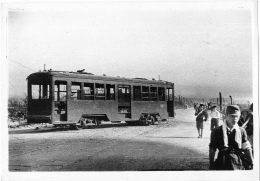 Since more and more men were called to the front lines during the war, there was a lack of personnel to work as conductors and drivers. To deal with this situation, Hiroshima Electric Railway established a girls’ boarding to educate female students as they worked. For two years starting from 1943, 300 female students around the age of 15 worked as drivers and conductors. 30 of these students and one of the teachers were killed in the bombing.
Since more and more men were called to the front lines during the war, there was a lack of personnel to work as conductors and drivers. To deal with this situation, Hiroshima Electric Railway established a girls’ boarding to educate female students as they worked. For two years starting from 1943, 300 female students around the age of 15 worked as drivers and conductors. 30 of these students and one of the teachers were killed in the bombing.
The streetcars that survived the bombing are used by students on school trips and the like in order to pass on the memories of the bombing. This summer, on the 70th anniversary, in addition to the two cars that are normally in service, another streetcar that was bombed (No. 653) will also be operated with its paint restored to what it was at the time of the bombing. Inside the car, monitors will play videos of statements by hibakusha and information about reconstruction efforts.
◆The tour will visit the Hiroshima Electric Railway depot, and have a guided tour of a streetcar that survived the atomic bomb and is in service to this day.
―――Unique Local Companies, sharing the postwar path with Hiroshima―――
8. Mazda Motor Corporation
An automobile manufacturer whose history is intertwined with Hiroshima’s.
Pursuing a unique style, the company has recorded its highest profits yet.
http://www.mazda.com/en/about/profile/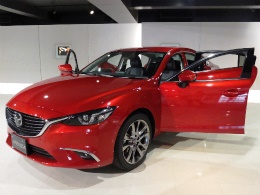
http://www.mazda.com/en/about/museum/
-Record profits for the 2014-2015 fiscal year
Due in part to the prevalence of iron-making in the area, Mazda was founded in Hiroshima in 1920. Even after the atomic bombing in 1945, four months later they had restarted production of their three-wheeled trucks. The company supported Hiroshima’s reconstruction and became a foundation of the local economy and industry with diverse automobile production. Mazda has the 4th largest share of registered vehicles in Japan.
Mazda is becoming a focus of attention once again. The company’s results for the 2014-2015 fiscal year included a year-on-year increase of 11.4% for operating income, to 202.9 billion yen, for the second consecutive year of record profits. The number of vehicles sold worldwide increased by 5% year-on-year, to 1,397,000 units, making it the most sold by Mazda for 20 years. In particular, sales in North America, Europe and China were doing well, with continuing popularity even considering the exchange rate.
- New technology developed by reviewing production during a slump
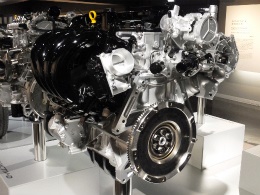 The healthy sales are being led by SKYACTIV, a group of fuel-efficient technologies developed by Mazda. Including technologies for engines with increased combustion efficiency, transmissions with smooth shifting and increased fuel efficiency, and platforms that are both light and durable, Mazda has created non-hybrid vehicles with the fuel efficiency of a hybrid vehicle. Diesel cars using SKYACTIV are also popular, as fuel costs are lower thanks to diesel being less expensive than gasoline, but they still have powerful engines. The Mazda3 was also chosen as a finalist for the 2014 World Car of the Year. Car-lovers around the world are said to be choosing Mazda cars due to their excellent handling and how fun it is to drive them.
The healthy sales are being led by SKYACTIV, a group of fuel-efficient technologies developed by Mazda. Including technologies for engines with increased combustion efficiency, transmissions with smooth shifting and increased fuel efficiency, and platforms that are both light and durable, Mazda has created non-hybrid vehicles with the fuel efficiency of a hybrid vehicle. Diesel cars using SKYACTIV are also popular, as fuel costs are lower thanks to diesel being less expensive than gasoline, but they still have powerful engines. The Mazda3 was also chosen as a finalist for the 2014 World Car of the Year. Car-lovers around the world are said to be choosing Mazda cars due to their excellent handling and how fun it is to drive them.
Although Mazda is currently doing well, at one point it was a long slump. From the 2008-2009 fiscal year to the 2011-2012 fiscal year, Mazda was in the red for four consecutive years. To overcome this crisis, Mazda reviewed its production in an interdisciplinary way including everything from design to production, and worked on reducing costs.
-Release of a new sports car, technological collaboration with Toyota
In May 2015, Mazda announced the first new model in 10 years for their popular sports car, the Roadster. This model weighs 100 kilograms less than the previous model, making it the topic of much discussion. Also in May, Mazda announced an expansion of collaboration with Toyota focusing on environmental technologies. With Toyota being a leader in fuel-cell vehicles and other cutting-edge technologies, and Mazda’s fuel efficient technologies for standard vehicles, this collaboration should be mutually beneficial.
◆The tour will visit Mazda’s head office, and hear about their management strategy from management personnel. The tour will also visit the Mazda Museum, and see unique SKYACTIV technology, the new roadster, and other topical vehicles.
9. Otafuku Sauce Co., Ltd.
The sauce supporting okonomiyaki, Hiroshima’s soul food born during the reconstruction period after the war
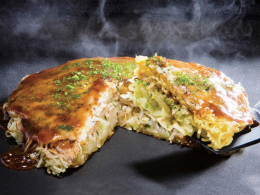 Okonomiyaki is beloved as a trademark food of Hiroshima. What is unique about Hiroshima okonomiyaki is that batter made with flour in water is thinly spread on a griddle and cooked, before piling on cabbage and other ingredients. Otafuku Sauce makes the sauce that defines the taste. They produce 20,000 kiloliters of the sauce per year, and with about a 70% share of the national okonomiyaki sauce market are in a commanding 1st place.
Okonomiyaki is beloved as a trademark food of Hiroshima. What is unique about Hiroshima okonomiyaki is that batter made with flour in water is thinly spread on a griddle and cooked, before piling on cabbage and other ingredients. Otafuku Sauce makes the sauce that defines the taste. They produce 20,000 kiloliters of the sauce per year, and with about a 70% share of the national okonomiyaki sauce market are in a commanding 1st place.
Okonomiyaki became popular at food stalls in Hiroshima after the war, with a lack of goods in the burnt wasteland it had become. Using the flour that had been sent as aid from overseas, cabbage was added to increase the volume and make it more filling. It is also said that thanks to the area being known for heavy manufacturing, it was relatively easy to get the iron griddle necessary to start a business. There were also many cases of widows who had lost their husbands to the war or the bombing opening up an okonomiyaki restaurant using part of their home.
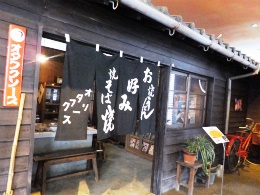 Sasaki Shoten, the predecessor to Otafuku Sauce, started in 1938 producing vinegar, but the store was destroyed in the bombing. After the war, while producing Worcestershire sauce to sell to okonomiyaki restaurants, a sauce more fitting for okonomiyaki was developed. After a process of trial and error, the thicker okonomiyaki sauce was created.
Sasaki Shoten, the predecessor to Otafuku Sauce, started in 1938 producing vinegar, but the store was destroyed in the bombing. After the war, while producing Worcestershire sauce to sell to okonomiyaki restaurants, a sauce more fitting for okonomiyaki was developed. After a process of trial and error, the thicker okonomiyaki sauce was created.
Otafuku Sauce has also expanded overseas, with the desire to have okonomiyaki become better known as one example of Japanese food. In addition to exporting to approximately 50 countries worldwide, in 2013 the company built factories in Los Angeles, USA and Qingdao, China in order to manufacture their products locally.
◆The tour will visit Otafuku Sauce, and sample okonomiyaki after seeing a cooking demonstration. A manager from the international business section will provide explanations as the tour visits the Okono Museum, with displays on the history and culture of Hiroshima okonomiyaki.
[ Tour Itinerary and Application Details ]
1. Itinerrary: July 9, Thursday to July 10, Friday (One night and two days)
【Day 1:Thursday, July 9】
08:15-09:40 Haneda Airport to Hiroshima Airport (ANA 673)
10:50-11:20 (30m) Atomic Bomb Dome
11:30-12:45 (1h15m) Hiroshima Peace Memorial Museum
12:45-13:15 (30m) Lunch
13:15-14:00 (45m) Interview with Hiroshima Peace Culture Foundation, Chairperson Yasuyoshi Komizo
14:30-16:15 (1h45m) Interview with Hiroshima A-bomb Survivors’ Association, President Sunao Tsuboi
17:00-18:15 (1h15m) Interview with High School Ambassadors
18:45-20:00 (1h15m) Otafuku Sauce (Dinner)
20:30 Arrive at hotel
【Day 2: Friday, July 10】
8:45 Leave hotel
9:00-10:30 (1h30m) Interview with a successor
11:00-11:45 (45m) Interview with Mayor Kazumi Matsui
12:15-13:00 (45m) Lunch
13:15-14:15 (1h) Hiroshima Electric Railway/ Streetcars that survived A-bomb
14:45-17:45 (3h) Mazda Motor Corporation
19:30-20:50 (1h20m) Hiroshima Airport to Haneda Airport (ANA 686)
2. Qualification: Bearer of Gaimusho Press Registration Card
3. Cost: 20,000 yen per person including transportation, meals and accommodation
* FPCJ will later inform the participants of methods for payment, cancellation fee etc.
4. Participants: Limited to 10 applicants.
(Only one reporter and one photographer from each company, but two participants from each TV team will be acceptable.)
5. FPCJ Contact: Ms. Chika Yoshida (Tel: 03-3501-3405)
6. Remarks:
(1) There may be some restrictions on photographing and filming at the tour sites. Please follow the instructions of the officials on duty.
(2) FPCJ and Hiroshima City will not be liable for any inconvenience, trouble or accident that might occur in the course of the tour.
(3) Participants will have to cover a portion of the cost for this press tour, but it is not a profit-making enterprise.
---- ---- ---- ---- ---- ---- ---- ---- ---- ---- ---- ---- ---- ---- ----
*Photo credits for this article (unauthorized use of these images is forbidden)
(2)-d is archived at the Hiroshima Peace Memorial Museum, the rest were all provided by the Hiroshima Peace Memorial Museum
(1)Introduction:
The first photo (US Army photo)
(2) Tour Details 5. Hiroshima Peace Memorial Museum
(2)-a Text, right: (US Army photo)
(2)-b Text, lower left: Left photo (US Army photo)
(2)-c Text, lower left: (Photo by Gonichi Kimura)
(2)-d Text, lower right image: (Artist: Kichisuke Yoshimura)
(3) Tour Details 7.
Hiroshima Electric Railway Streetcars That Survived the Bomb: (Photo by Mitsugi Kishida)
---- ---- ---- ---- ---- ---- ---- ---- ---- ---- ---- ---- ---- ---- ---
-


